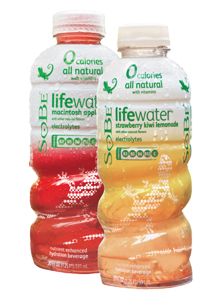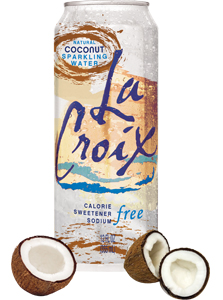Bottled water sales get refreshed
Sparkling, enhanced waters deepen category’s reach

|
|
Pepsi-Cola North America Beverages’ SoBe Lifewater with electrolytes released Strawberry Kiwi Lemonade and Macintosh Apple Cherry. Both are infused with vitamins and sweetened with PureVia for zero calories in each serving. |
Bottled water sales have shown signs of growth as the category recovers from the effects of the recession. Overall, the bottled water category increased 2 percent for $7.8 billion in sales for the 52 weeks ending Aug. 7 in supermarkets, drug stores, gas and convenience stores and mass merchandise outlets, excluding Wal-Mart, according to SymphonyIRI Group, Chicago.
Still bottled water sales reported 1.7 percent growth during the same time period for $6.5 billion in sales, while bulk water sales remained flat at more than $853.3 million, the market research firm reports. Sparkling bottled water increased 11.8 percent for $437.7 million in total sales in measured channels, according to SymphonyIRI.
“In 2010, [sales] have been quite flat, and of course the recession is one of the reasons, but the other reason is because the category has become highly promotional where we see frequent price promotions,” says Garima Goel Lal, senior analyst at Mintel International, Chicago. “The other thing is private label has very high market share in bottled water.”
Private label still bottled water is the No. 1 selling bottled water and makes up 15.5 percent of the market share in SymphonyIRI’s measured channels. In the 52 weeks ending Aug. 7, private label still bottled water posted $1 billion in sales, a nearly 4 percent increase, according to SymphonyIRI. During that same time period, private label bulk water accounted for 39 percent of that segment’s market share and remained flat in sales, while private label sparkling bottled water increased nearly 3 percent for 24.4 percent of that segment’s market share.
“People see very little difference in quality between branded and private label,” Goel Lal says. “[Mintel] just did [its] private label report and according to our survey, bottled water is the second biggest product that people see very little difference between the branded and private label products.”
In addition to sales increases, earlier this year the International Bottled Water Association, in conjunction with the Beverage Marketing Corp., released 2010 bottled water statistics that showed that overall consumption of bottled water has increased by 3.5 percent.
Goel Lal says Mintel forecasted that bottled water sales will grow by 39 percent between 2010 and 2015.
“I think bottled water is essentially very simple and uncomplicated for people,” says Jane Lazgin, director of corporate communications for Nestlé Waters North America (NWNA). “I think that it answers to a lot of beverage and food desires that people have. I think people are always going to drink a variety of things during the course of their day, but they are looking to get more water into their lives, particularly those of their children. It’s an evolving trend.”
NWNA brands include Nestlé Pure Life, which increased almost 29 percent in sales, based on SymphonyIRI data. Lazgin says the company’s volume sales were up 6.5 percent, outpacing the overall bottled water category.
Enhancing sales
Mintel’s Goel Lal says the main growth factor for the convenience still bottled water segment will be enhanced waters, which have done well, she adds.
“People generally associate bottled water with good-for-you beverages, and initially when enhanced water cropped up and started coming into the market, people started moving to these enhanced waters from fruit juice and sports drinks because they thought they were moving to a lower calorie beverage, but at the time, most enhanced waters were pretty high in calories,” she says. “So removing calories from enhanced water has answered people’s perception that enhanced water is indeed low-calorie but gives you a variety of flavors, so it still gives you exponential benefits, but without the calories.”
The Coca-Cola Co.’s wholly owned subsidiary Glaceau Vitaminwater Zero increased its sales nearly 160 percent and is No. 9 among the top-selling still bottled waters for the 52 weeks ending Aug. 7, SymphonyIRI states.
A division of Purchase, N.Y.-based PepsiCo, Pepsi-Cola North America Beverages’ SoBe Lifewater Zero didn’t make the Top 10, but made strides with close to an 18 percent increase.

|
|
National Beverage Co.’s LaCroix sparkling bottled water brand introduced its eighth flavor, a Coconut variety. |
Earlier this year, the company released SoBe Lifewater with electrolytes in two new varieties: Strawberry Kiwi Lemonade and Macintosh Apple Cherry. Both are infused with vitamins and sweetened with the stevia-based sweetener PureVia for zero calories in each serving. Each 8-ounce serving of the waters contains 80 mg. of potassium and 10 percent of the daily value of niacin, vitamin C and vitamins B6 and B12.
Other companies also have entered the enhanced bottled water segment. Blk Beverages LLC, New York City, launched its original product, Blk, which is a black-colored enhanced water.
“It’s black because we add something to the water called fulvic acid,” says Albie Manzo with Blk Beverages. “Fulvic acid comes from the root of plants and its primary purpose in plant life is to take nutrients from the soil and transport it into the cells of the plants to help it grow.”
Manzo adds that the water is comprised of 77 different trace minerals, elements, antioxidants and electrolytes.
“I get asked all the time, ‘What’s your competition? Or who should drink this?’” he says. “There’s a function in this water for anybody. Whether it’s older people or the younger generation women, men, no matter who you are, there’s a function in this water for you.”
The company showcased three flavor varieties of Blk water at Natural Products Expo East in September that it plans to launch soon. “I think the flavors are going to help us in a big way to get people because it does still taste like water,” Manzo says. “And that’s great to one extent because if you are really health-conscious and you want those electrolytes, you want those antioxidants and you don’t want the drawbacks, that’s great, but if you just want to drink water, people tend to want to drink what they are accustomed to. I think the flavors are going to be big in that scenario because it’s going to get us to a little bit of a wider audience.”
The enhanced bottled water segment also has seen brands reposition their products to capitalize on the category’s appeal. Originally positioned as a kids’ drink, Bot Beverages, Princeton, N.J., repositioned its Bot water to appeal to a broader audience.
“After we launched Bot, we immediately saw an opportunity for a slightly sweet, all-natural enhanced water for adults — a water with benefits,” says Brian Allen, co-founder and chief operating officer of Bot Beverages. Allen adds that the economic downturn and the price point of the children’s beverage category played a role in the decision to rebrand the beverage. For example, Bot is priced at $1.49 a bottle compared to the common price of $1.89 for 10 juice boxes, he says. But shifting to an enhanced bottled water platform also will help address consumer desires for health-conscious products, Allen says.
“Consumer trends toward healthier lifestyles have increased the demand for a less sweet option,” he says. “Basically, they drink water because it is healthy, but sometimes [they] want that added benefit and taste — without tons of calories and the sweetness of a soda. I can’t speak for others in the category, but when marketing Bot, we call out that we have the added value of the nutrients and minerals while still maintaining the essence of water. Our consumers like us because we drink like a water — light, crisp, clear and clean — but we deliver added benefits.”
Allen also sees potential in the zero-calorie market for the company to grow. As a result, the company is in the process of developing a calorie-free option.
Sparkling future
Growth potential for the bottled water category also can be found within the sparkling water segment. “Sparkling bottled water is the fastest growing bottled water segment with 10 percent growth versus [a year ago] and only 6 percent penetration in the market,” says Carolina Rodriguez, senior brand manager with Nestlé Waters. “With consumers’ desires to find good-for-you and natural beverage options for their hydration needs, Nestlé Waters Regional Spring Water Sparkling brands represent a great opportunity to provide people with a refreshing and tasteful beverage alternative.”
Nestlé Waters sparkling water brands include Perrier, San Pellegrino and Arrowhead, which saw sales increase nearly 7 percent, almost 16 percent and close to 40 percent, respectively, for the 52 weeks ending Aug. 7, based on SymphonyIRI data. The company’s Poland Spring sparkling water brand was flat during that same time period.
The sparkling water segment saw nine of the Top 10 brands experience moderate to large growth. “[Sparkling bottled waters] have performed better than [still] and bulk segments and one of the reasons is the key demographic group for mineral water is young adults ages 18 to 24 and Hispanics and African-Americans,” says Mintel’s Goel Lal. “The other reason is when I look at the brands, the premium brands have done better, like Perrier and San Pellegrino, so there’s a combination of things going on there.”
Goel Lal adds that consumers also might be drinking more sparkling waters at restaurants or as an alternative to carbonated soft drinks.
In late 2010, Talking Rain Beverage Co. introduced Sparkling Ice carbonated water made with spring water, natural fruit juice, vitamins and antioxidants. Sparkling Ice sales were more than $12 million for the 52 weeks ending Aug. 7, SymphonyIRI states.
National Beverage Co.’s LaCroix sparkling bottled water brand also introduced a new flavor variety: Coconut. Like its predecessors, the product is all-natural, caffeine-free, sugar-free and sodium-free. The new release brings the company’s total flavors to eight varieties. BI
Looking for a reprint of this article?
From high-res PDFs to custom plaques, order your copy today!





